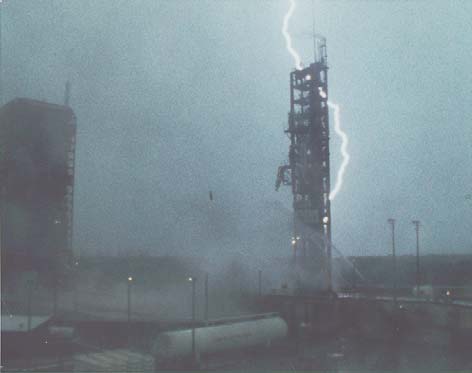Mission Critical: Weather Prediction for Space Launches
- By William Roeder
- Mar 26, 2021
How does a rocket get to space? For that, it needs the help of a very special team of weather forecasters.
The 45th Space Wing Weather Squadron (45 WS) provides comprehensive weather services to America’s space program at Cape Canaveral Air Force Station (CCAFS), NASA’s Kennedy Space Center (KSC) and Patrick Air Force Base. These services include weather support for pre-launch, launch, post-launch, routine weather forecast, 24/7 watches/warnings, flight briefings, and special missions.
A major part of the 45 WS support to launch is evaluating and forecasting the Lightning Launch Commit Criteria (LLCC) and User Launch Commit Criteria. The LLCC protect against natural and rocket triggered lightning strikes to the in-flight rocket. The User Launch Commit Criteria include low level winds so the rocket doesn’t topple or get blown back into the launch pad during launch, and ceiling and visibility so the ascending rocket can be tracked by camera to ensure it is on the correct trajectory. Launch customers include the DoD, NASA, and commercial customers. The launch vehicles supported have included Titan, Atlas, Delta, Athena, Pegasus, and Space Shuttle space launch vehicles, SpaceX launches, and Trident ballistic missiles.
The 45 WS also provides weather information to other offices that evaluate and forecast other Launch Commit Criteria on weather impacts. These other Launch Commit Criteria include aerodynamic loading on in-flight rockets from upper winds and overall safety support for the Eastern seaboard. Weather impacts decisions on toxic dispersion, acoustic overpressure from exploding rockets, and debris fallout. All this takes place on the coast of east central Florida, which is known as the ‘Lightning Alley’ of the U.S.
The Tools They Use
In order to perform these important duties, the 45 WS is especially well instrumented with lightning detection sensors. The daily lightning reports issued by 45 WS requires high performance cloud-to-ground lightning locating. These reports are used to help assess the risk of induced current damage to electronics in satellite payloads, space launch vehicles, ground test equipment, and facilities. The reports include the location for each return stroke, location error ellipse, peak current, and other data.
Other applications of the cloud-to-ground lightning locating include forecasting for lightning warnings via continuity, incident investigation, development of forecast techniques, and climatology. In addition to the cloud-to-ground lightning system, the lightning aloft system is used to evaluate the Lightning Launch Commit Criteria to avoid triggered and natural lightning to the in-flight space launch vehicle, and to issue lightning warnings to gain lead-time over just cloud-to-ground lightning detection.
History of the Lightning Launch Commit Criteria
The LLCC have undergone numerous changes since the 1960s. These changes were driven by operational incidents, scientific improvements, or new weather sensors. The LLCC are in a process of continuous improvement and more changes are expected in the future. Here are a few historical pieces that were responsible for significant changes in the criteria:
4.1. Apollo-12 (1969)
The danger of rocket triggered lightning to large rockets was first recognized when Apollo-12 suffered two lightning strikes during its launch in 1969. Fortunately, the mission was completed safely, although the rocket required some in-flight maintenance. Prior to Apollo-12 the only LLCC was to avoid flying through cumulonimbus or thunderstorm clouds. After Apollo-12, the first set of LLCC resembling the modern rules was created. These rules recognized that large rockets could trigger lightning under conditions that would not generate natural lightning and prohibited launch when those phenomena were present.
4.2. Special Weather Sensors (1973-1975)
NASA next used several special weather sensors during 1973-1975 to help launch high-visibility and/or short-window missions such as Skylab, Apollo-Soyez, and Viking. Some of the special sensors were later implemented into routine operations, including the Lightning Detection And Ranging system that detects all types of lightning and the Launch Pad Lightning Warning System that detects electric fields at the surface. Other special weather sensors were used at that time but not institutionalized, e.g. an X-band weather radar and airborne field mills. Even though those sensors were not implemented into routine operations, their data proved useful in subsequent LLCC changes.
4.3. Atlas/Centaur-67 (1987)
A possible triggered lightning strike occurred to Atlas-38 in 1976. The only impact was degraded telemetry for about 30 seconds—the mission completed successfully. This event apparently was not investigated deeply from the triggered lightning perspective. No changes were made to the LLCC as a result of this event.
The next major event in the LLCC evolution was the 1987 Atlas/Centaur-67 (AC-67) accident. The AC-67 caused a triggered lightning strike, which disrupted the vehicle guidance electronics and caused an erroneous steer command. As the rocket turned sideways, aerodynamic loading caused it to begin breaking-up. Range Safety then sent a telemetry destruction command to ensure the debris crashed in allowable areas and would not threaten civilian populations.
Several studies (Heritage, 1988), and several working groups, produced many LLCC recommendations after the AC-67 accident. As a result of all these competing, and sometimes disparate LLCC recommendations, the 45 WS and NASA Headquarters formed the Peer Review Committee (now Lightning Advisory Panel (LAP)) to advise the USAF and NASA on LLCC issues. This led to a major revision of the LLCC in 1988 (Aerospace, 1988). Since AC-67, there have been no triggered lightning strikes to rockets launched using the modern LLCC.

This article has been edited and abridged specifically for the AMS Weather Band. Any errors or omissions may be attributed to AMS staff.
